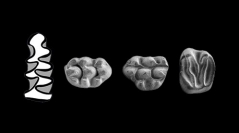

 Comptes Rendus Palevol
15 (6) - Pages 659-668
Comptes Rendus Palevol
15 (6) - Pages 659-668In this paper we analyze the rodent assemblage from the Early Pleistocene site of Gruta1 (Quibas karstic complex, Murcia, SE Spain), providing taphonomic comments and paleoecological and paleoclimatic data. The studied assemblage includes 209 identified rodent teeth corresponding to at least four taxa. The karstic source of the site and the low presence of digested remains suggest that the accumulation is scatological in origin, with the influence of predators such as owls; the accumulation also shows certain evidence of slight hydrodynamic sorting. For the area around Quibas/Gruta1 the paleoecological study indicates a predominance of rocky areas (31.7%), forested environments (31.7%) and open dry meadows or shrublands (29.7%), which would indicate a mosaic forest environment, and to a lesser extent the presence of open humid land (5.4%) and areas along streams or ponds (1.5%). The distribution of the bioclimatic spectra yields the highest percentage for a Mediterranean climate (37.5%), while the climatic parameters calculated (MAT = 15 °C, MTW = 25.7 °C, MTC = 4.3 °C, MAP = 390 mm) suggest colder and slightly more humid conditions than today at the time of the deposition of the remains. The data also point to a relative decrease in temperature within the phase in which the site was produced, which possibly occurred during a relative cold period between MIS 36 and MIS 40 according to the age.
Paleoecology, Paleoclimatology, Taphonomy, Rodentia, Early Pleistocene, Iberian Peninsula